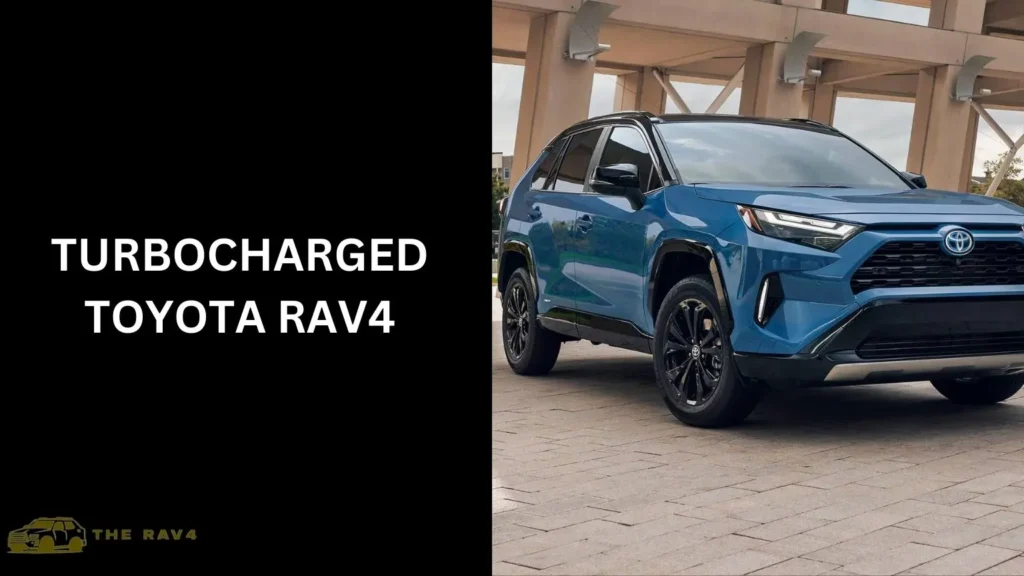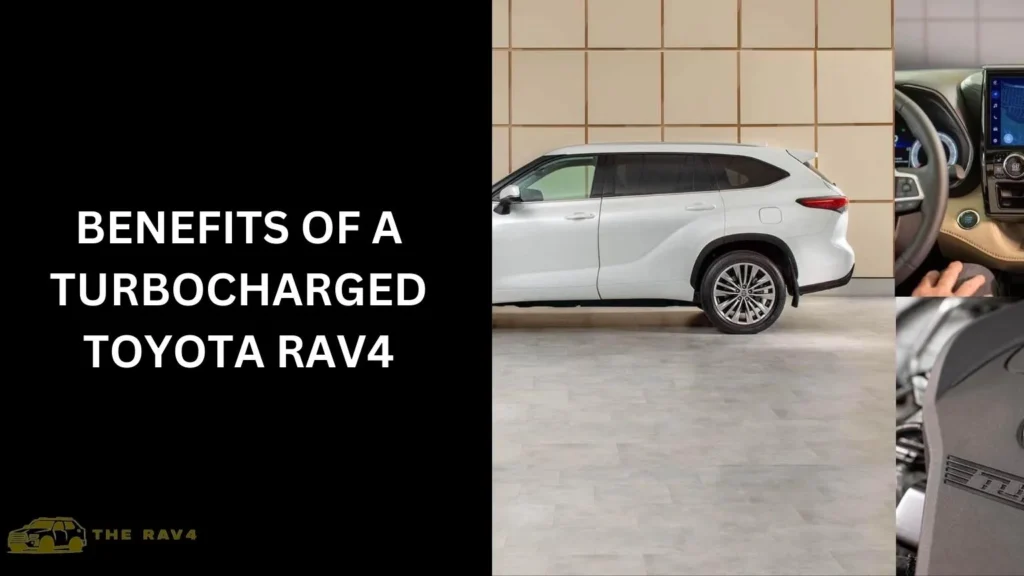The Toyota RAV4 has long been a stalwart in the compact SUV segment, known for its reliability, versatility, and robust performance.
Turbocharged Toyota RAV4, However, with technological advancements and changing consumer preferences,
Toyota has introduced a turbocharged variant of the RAV4, ushering in a new era of driving excitement and efficiency.

Introduction to the Toyota RAV4
The Toyota RAV4, first introduced in the 1990s, quickly gained popularity as a compact crossover SUV.
Over the years, it has undergone significant transformations, evolving into a sophisticated and feature-rich vehicle.
Evolution of the RAV4
From its humble beginnings as a small, utilitarian SUV, the RAV4 has evolved into a stylish and modern vehicle. With each generation, it has embraced new technologies, enhanced performance capabilities, and refined aesthetics.
Turbocharged Engine: What It Means
The turbocharged variant of the Toyota RAV4 is equipped with a turbocharger, a device that compresses air entering the engine.
This compressed air allows the engine to burn more fuel and generate additional power, resulting in improved performance.
Benefits of a Turbocharged Toyota RAV4

The Turbocharged Toyota RAV4 offers several benefits that elevate its driving experience and overall appeal:
Performance and Handling
The turbocharged engine delivers exhilarating performance, offering increased horsepower and torque. This translates to quicker acceleration and enhanced responsiveness, making every drive a thrilling experience.
Fuel Efficiency
Despite the added power, the turbocharged RAV4 remains fuel-efficient. The engine’s ability to extract more energy from each drop of fuel contributes to better mileage, reducing the overall cost of ownership.
Safety Features
Toyota prioritizes safety, and the turbocharged RAV4 is no exception. It comes equipped with advanced safety features, including collision avoidance systems, adaptive cruise control, and lane departure warning, ensuring a secure driving experience.
Interior Comfort and Technology
Inside the turbocharged RAV4, passengers are treated to a spacious and well-appointed cabin. Premium materials, ergonomic design, and cutting-edge technology create a luxurious yet functional environment.
Comparison with Non-Turbocharged Models
Compared to its non-turbocharged counterparts, the turbocharged RAV4 stands out with its dynamic performance and enhanced capabilities. It offers a perfect blend of power, efficiency, and versatility, appealing to a wide range of drivers.
Pricing and Value Proposition
While the turbocharged variant may come at a slightly higher price point, its added features and performance justify the investment. Customers receive exceptional value, enjoying a superior driving experience and long-term satisfaction.
Customer Reviews and Satisfaction
Feedback from customers who have experienced the turbocharged RAV4 has been overwhelmingly positive.
They praise its smooth acceleration, precise handling, and overall refinement, highlighting its status as a top contender in its class.
Future of Turbocharged Vehicles
As automakers continue to innovate, turbocharged engines are expected to become more prevalent across different vehicle segments.
Their ability to deliver increased power without sacrificing fuel efficiency makes them a compelling choice for modern drivers.
Here are some key trends and developments shaping the future of turbocharged vehicles:
Hybridization and Electrification
As the automotive industry transitions toward cleaner and more sustainable technologies, turbocharged engines are being integrated into hybrid and electric powertrains.
This combination leverages the instant torque delivery of electric motors with the efficiency and power boost of turbocharging, offering a compelling blend of performance and eco-friendliness.
Downsized Engines
Manufacturers are increasingly downsizing engines while incorporating turbocharging to maintain or even enhance performance levels.
This trend is driven by stricter emissions regulations and consumer demand for fuel-efficient yet powerful vehicles.
Turbochargers enable smaller engines to deliver comparable power to larger ones, resulting in reduced fuel consumption and emissions.
Advanced Materials and Engineering
The future of turbocharged engines involves advancements in materials and engineering techniques.
Lightweight materials such as high-strength alloys and carbon fiber are being utilized to reduce turbocharger weight and improve efficiency.
Additionally, advancements in aerodynamics and thermal management are optimizing turbocharger performance and reliability.
Variable Geometry Turbochargers
Variable geometry turbochargers (VGTs) are becoming increasingly prevalent in modern turbocharged engines.
These turbochargers feature adjustable vanes or nozzles that optimize airflow and boost pressure based on engine speed and load.
VGTs enhance responsiveness, eliminate turbo lag, and improve overall efficiency compared to traditional fixed-geometry turbochargers.
Integration with Mild Hybrid Systems
Turbocharged engines are being integrated with mild hybrid systems, where a small electric motor assists the engine during acceleration or at low speeds.
This combination, known as turbo-mild hybridization, enhances torque delivery, reduces turbo lag, and improves fuel efficiency by recuperating energy during deceleration and braking.
AI and Engine Management
Artificial intelligence (AI) and advanced engine management systems are playing a crucial role in optimizing turbocharged engine performance.
AI algorithms analyze real-time data from sensors, optimizing fuel injection, turbo boost pressure, and other parameters for maximum efficiency and power output.
This intelligent control enhances drivability, responsiveness, and overall engine reliability.
Continued Performance Improvements
The ongoing development of turbocharging technology is focused on extracting more performance while meeting stringent emissions standards.
Innovations such as twin-scroll turbochargers, electric turbochargers, and integrated exhaust gas recirculation (EGR) systems are enhancing efficiency, reducing turbo lag, and boosting overall power delivery.
Environmental Impact and Sustainability
Despite the performance benefits, turbocharged engines are designed to meet stringent emissions standards. Toyota remains committed to sustainability, implementing eco-friendly practices throughout the production and lifecycle of its vehicles.
People also ask
Does the Toyota RAV4 have a turbocharged engine?
The Toyota RAV4 does not have a turbocharged engine in its standard models.
However, Toyota offers a hybrid version of the RAV4, known as the RAV4 Hybrid, which combines a gasoline engine with an electric motor for improved efficiency and performance.
Does the RAV4 have a powerful engine?
Is there a fast RAV4?
Yes, Toyota offers a faster and more performance-oriented version of the RAV4 called the RAV4 Prime.
It features a plug-in hybrid powertrain with a more powerful engine and electric motor combination, resulting in quicker acceleration and improved performance compared to the standard RAV4 models.
Did RAV4 have a V8?
No, the Toyota RAV4 has never been offered with a V8 engine. It has typically been equipped with four-cylinder engines, hybrid powertrains, or, in some cases, a V6 engine.
Conclusion
In Conclusion, The turbocharged RAV4 represents a significant leap forward in automotive engineering, combining power, efficiency, and sophistication.
With its impressive performance credentials, advanced features, and positive reception from customers, it sets a high standard for compact SUVs.
